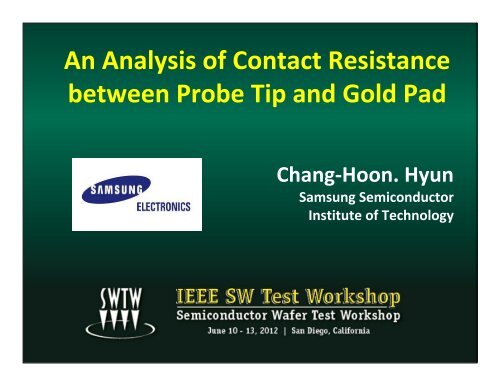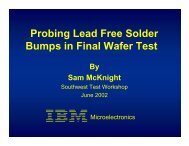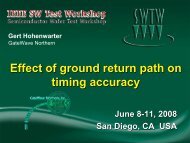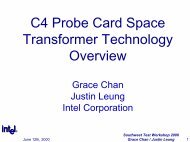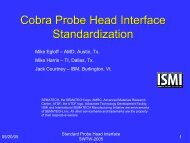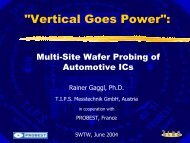An Analysis of Contact Resistance between Probe Tip and Gold Pad
An Analysis of Contact Resistance between Probe Tip and Gold Pad
An Analysis of Contact Resistance between Probe Tip and Gold Pad
You also want an ePaper? Increase the reach of your titles
YUMPU automatically turns print PDFs into web optimized ePapers that Google loves.
<strong>An</strong> <strong>An</strong>alysis <strong>of</strong> <strong>Contact</strong> <strong>Resistance</strong><br />
<strong>between</strong> <strong>Probe</strong> <strong>Tip</strong> <strong>and</strong> <strong>Gold</strong> <strong>Pad</strong><br />
Company<br />
Logo<br />
Chang‐Hoon. Hyun<br />
Samsung Semiconductor<br />
Institute <strong>of</strong> Technology
Contents<br />
• Model <strong>of</strong> <strong>Probe</strong> <strong>Tip</strong> Contamination by Al Oxide<br />
• Introduction to <strong>Gold</strong> <strong>Pad</strong> Structure<br />
• Relationship <strong>of</strong> Fine Pitch <strong>and</strong> <strong>Resistance</strong><br />
• <strong>Contact</strong> <strong>Resistance</strong> <strong>of</strong> <strong>Gold</strong> <strong>Pad</strong><br />
• Work Function <strong>of</strong> <strong>Tip</strong> <strong>and</strong> <strong>Pad</strong> Materials<br />
• <strong>Contact</strong> <strong>Resistance</strong> Measurement <strong>of</strong> <strong>Gold</strong> <strong>Pad</strong><br />
(Rhenium‐Tungsten vs Platinum <strong>Tip</strong>)<br />
• Summary<br />
1
Key Points<br />
• Modeling <strong>of</strong> Ti Oxide Creation<br />
• Probing Result <strong>of</strong> Fine Pitch Bump<br />
• The Surface <strong>An</strong>alysis <strong>of</strong> <strong>Gold</strong> <strong>Pad</strong><br />
• Ohmic Heating by Work Function Difference<br />
• <strong>Contact</strong> <strong>Resistance</strong> Measurement by ATE<br />
2
Model <strong>of</strong> <strong>Probe</strong> <strong>Tip</strong> Contamination<br />
Source : Jerry J. Broz, “<strong>Probe</strong> <strong>Contact</strong> <strong>Resistance</strong><br />
Variations during Elevated Temperature Wafer Test”<br />
Test Conference,1999<br />
by Al Oxide<br />
U : Voltage drop( U = Forcing Current × Cres)<br />
T bulk : Ambient Temperature<br />
α : Temperature Coefficient <strong>of</strong> Resistivity<br />
ρ : Resistivity at the Bulk Temperature<br />
λ : Thermal Conductivity<br />
※ a‐Spot : Real Inter‐Metallic <strong>Contact</strong> Area<br />
Conducting<br />
Metal to Metal a‐Spots<br />
Localized Joule Heating<br />
in a‐Spot Area during Test<br />
Al Oxide Film growth on <strong>Pad</strong>.<br />
<strong>Probe</strong> <strong>Tip</strong> Contamination<br />
3
Model <strong>of</strong> <strong>Probe</strong> <strong>Tip</strong> Contamination<br />
by Al Oxide<br />
<strong>Resistance</strong> <strong>of</strong><br />
<strong>Contact</strong> Area<br />
σ oxide‐films : Oxide film resistance<br />
A contact : <strong>Contact</strong> area<br />
Improve<br />
Oxide <strong>Resistance</strong> Reduction<br />
Oxide Film Restraint<br />
Al 2 O 3 Removal (FAB Control)<br />
Storage in an Inert Mood<br />
<strong>Tip</strong> Surface Cleaning<br />
<strong>Probe</strong> materials<br />
<strong>Contact</strong> Area Expansion<br />
Over‐drive (<strong>Contact</strong> pressure ↑)<br />
<strong>Probe</strong> tip shape<br />
4
Introduction to <strong>Gold</strong> <strong>Pad</strong> Structure<br />
Passivation<br />
<strong>Gold</strong><br />
UBM<br />
SEM (20kV, X50k)<br />
<strong>Pad</strong> Metal<br />
Wafer<br />
• <strong>Pad</strong> Material<br />
Aluminum<br />
• UBM (Under Barrier Metal)<br />
For Adhesion (Between <strong>Pad</strong> Metal <strong>and</strong> <strong>Gold</strong>)<br />
Materials are Ti <strong>and</strong> W<br />
• <strong>Gold</strong> Material<br />
Purity : 99.9%<br />
Scope Image (X100)<br />
5
Relationship <strong>of</strong> Fine Pitch <strong>and</strong> <strong>Resistance</strong><br />
A. Relationship <strong>of</strong> a‐Spot Reduction <strong>and</strong> Cres<br />
• What is Fine Pitch <strong>Gold</strong> Bump <strong>Pad</strong>?<br />
<strong>Pad</strong> Pitch : Under 30um<br />
<strong>Pad</strong> Width : Under 20um<br />
<strong>Resistance</strong>(Ω)<br />
Pitch<br />
Width<br />
[um]<br />
Width <strong>Tip</strong> Diameter<br />
30 12~10<br />
25 9~10<br />
20 7~8<br />
15 5~6<br />
Pitch size or Width(um)<br />
α : Diameter <strong>of</strong> contact spot<br />
n : Number <strong>of</strong> contact spot<br />
6
Relationship <strong>of</strong> Fine Pitch <strong>and</strong> <strong>Resistance</strong><br />
B. Experiment <strong>of</strong> Fine Pitch Probing<br />
• We made another Bump Width on Wafer<br />
<strong>Tip</strong> Diameter : 6um<br />
Yield Monitoring by using ATE<br />
15um<br />
11um<br />
Width:15um<br />
Probing Direction<br />
25um<br />
10um(<strong>Pad</strong> to <strong>Pad</strong>)<br />
Width:11um<br />
7
Relationship <strong>of</strong> Fine Pitch <strong>and</strong> <strong>Resistance</strong><br />
C. Experiment Result<br />
Measure<br />
<strong>Pad</strong> Width<br />
11um 15um<br />
Open Fail Ratio<br />
(Non Cleaning)<br />
93% 87%<br />
Open Fail Ratio<br />
(Interval 50Chip)<br />
10.4% 1.5%<br />
Bump Damage 50.7% 3.2%<br />
Visual Fail (SEC St<strong>and</strong>ard)<br />
Stick Out<br />
Bump<br />
Broken<br />
• Number <strong>of</strong> Total Chips : Etch 1000 die<br />
Z‐Height : Electrical First Pass + 10um<br />
Needle Polish Paper : 3M AlO 3 Lapping Film<br />
Cleaning T/D : 20 up‐down<br />
8
<strong>Contact</strong> <strong>Resistance</strong> <strong>of</strong> <strong>Gold</strong> <strong>Pad</strong><br />
A. Model <strong>of</strong> <strong>Probe</strong> <strong>Tip</strong> Contamination by Ti Oxide<br />
TiW + 2H 2 O 2 → (TiO 2 ↓) +2H 2 O<br />
Step 1 : Reaction <strong>of</strong> <strong>between</strong> Ti <strong>and</strong> H 2 O 2<br />
Step 2 : Reabsorption <strong>of</strong> TiO 2 on Bump Surface<br />
Classification Ti TiO 2<br />
Resistivity (μΩ∙cm) 43.1 10 18<br />
Dielectric Constant ‐ 110.00<br />
TiO 2 (↓)<br />
Ti+<br />
WO 5<br />
2‐(aq)<br />
<strong>An</strong>neal<br />
<strong>Probe</strong> <strong>Tip</strong><br />
TiW Etching (by H 2 O 2 )<br />
Wafer Electrical Test<br />
Au Bump<br />
9
<strong>Contact</strong> <strong>Resistance</strong> <strong>of</strong> <strong>Gold</strong> <strong>Pad</strong><br />
B. <strong>Resistance</strong> vs. <strong>Contact</strong> Count<br />
Before <strong>Contact</strong><br />
<strong>Probe</strong> <strong>Tip</strong><br />
Bump<br />
After <strong>Contact</strong><br />
<strong>Resistance</strong>(Ω)<br />
After Surface Cleaning<br />
(Same Situation to Aluminum)<br />
<strong>Pad</strong> to <strong>Tip</strong> Touch Count<br />
Oxide Film Absorption<br />
10
<strong>Contact</strong> <strong>Resistance</strong> <strong>of</strong> <strong>Gold</strong> <strong>Pad</strong><br />
C. ToF‐SIMS <strong>An</strong>alysis<br />
TiO2<br />
• Finding <strong>of</strong> Insulation Ingredient<br />
TiO<br />
TiW + 2H 2 O 2 →<br />
(TiO 2 ↓) +2H 2 O<br />
Ti<br />
Sputter Time (sec)<br />
11
Work Function <strong>of</strong> <strong>Tip</strong> & <strong>Pad</strong> Materials<br />
A. Relationship <strong>of</strong> Material’s Work Function<br />
PAD<br />
TIP<br />
Classification<br />
Work Function (φ) [eV]<br />
Aluminum 4.06 ~ 4.26<br />
<strong>Gold</strong> 5.10 ~ 5.47<br />
Tungsten (ReW) 4.32 ~ 5.22<br />
Platinum 5.12 ~ 5.93<br />
• We had to needle cleaning on <strong>Gold</strong> bump pad when used ReW <strong>Tip</strong><br />
Cleaning Interval : Average 35 Chip Card Life Time Reduction<br />
Wafer Moving Time Increase : 30~40 min/Wafer Production Loss<br />
• <strong>Tip</strong> Material Change Cleaning Interval : 1 Time a Wafer<br />
• Assumption : If Same Work Function <strong>of</strong> Material…<br />
12
Work Function <strong>of</strong> <strong>Tip</strong> & <strong>Pad</strong> Materials<br />
B. ReW or Pt <strong>Tip</strong> to <strong>Gold</strong> <strong>Pad</strong> <strong>Contact</strong><br />
Φ(Au) ‐ Φ(Pt)<br />
Φ(Au) ‐ Φ(W)<br />
Rhenium ‐ Tungsten<br />
Φ(Pt) = 5.12eV<br />
Pt<br />
Fermi level<br />
Au<br />
Fermi level<br />
Φ(Au) = 5.10eV<br />
W<br />
Fermi level<br />
Φ(W) = 4.32eV<br />
Φ(Au) ‐ Φ(W) = 0.82eV<br />
Platinum<br />
Au<br />
Electrons<br />
Electrons<br />
Electrons<br />
• <strong>An</strong> Ohmic contact is a junction <strong>between</strong> a metal <strong>and</strong><br />
a smaller work function metal<br />
Φ(Au) ‐ Φ(Pt) = 0.02eV<br />
• Joule heating, also known as ohmic heating <strong>and</strong> resistive heating<br />
• If ΔeV increase, Ohmic heating will increase<br />
Au<br />
13
<strong>Contact</strong> <strong>Resistance</strong> Measurement<br />
<strong>of</strong> <strong>Gold</strong> <strong>Pad</strong>(ReW vs. Pt <strong>Tip</strong>)<br />
A. <strong>Tip</strong> Material Resistivity Measurement<br />
<br />
I<br />
1 2 3 4<br />
V<br />
s s s<br />
2<br />
<br />
I<br />
1<br />
<br />
2<br />
s<br />
I<br />
<br />
1 <br />
;<br />
2s<br />
<br />
V<br />
3<br />
2s<br />
V<br />
I<br />
I<br />
1<br />
<br />
2<br />
2s<br />
cm<br />
1 <br />
<br />
s <br />
KEITHLEY 2750 / Cmpl V : 2.1 / I = 100mA<br />
<strong>Tip</strong> Material<br />
<strong>Resistance</strong><br />
(Ω)<br />
Resistivity<br />
(uΩ∙ cm)<br />
Rhenium‐<br />
Tungsten<br />
0.93 9.35<br />
Platinum 3.48 35.01<br />
A<br />
V<br />
V<br />
V<br />
23<br />
V<br />
2<br />
V<br />
3<br />
I<br />
1<br />
<br />
2<br />
2s<br />
1<br />
<br />
s<br />
1<br />
<br />
2s<br />
1 <br />
<br />
s <br />
Source : D. K. Schroder, “Semiconductor Material <strong>and</strong><br />
Device Characterization”, 3rd edition, 2006<br />
<br />
I<br />
2s<br />
S = 50mm<br />
14
<strong>Contact</strong> <strong>Resistance</strong> Measurement<br />
B. General Method Using DMM<br />
<strong>of</strong> <strong>Gold</strong> <strong>Pad</strong>(ReW vs Pt <strong>Tip</strong>)<br />
• Source : Keithley 2750<br />
Multimeter/Switch/Data Acquisition system<br />
• <strong>Probe</strong>r<br />
Wafer H<strong>and</strong>ler<br />
<strong>Pad</strong> to <strong>Tip</strong> Automatic <strong>Contact</strong> & Probing<br />
P‐8 (TOKYO Electronics Ltd.)<br />
Up‐Down<br />
Bare Wafer<br />
Deposited <strong>Gold</strong><br />
(5um)<br />
15
<strong>Contact</strong> <strong>Resistance</strong> Measurement<br />
C. Measurement Result (DMM)<br />
<strong>of</strong> <strong>Gold</strong> <strong>Pad</strong>(ReW vs Pt <strong>Tip</strong>)<br />
<strong>Contact</strong> <strong>Resistance</strong> [Ω]<br />
10.0<br />
8.0<br />
6.0<br />
4.0<br />
2.0<br />
0.0<br />
Sample 01<br />
Sample 02<br />
Sample 03<br />
Sample 04<br />
ReW <strong>Tip</strong><br />
10 50 100<br />
Number <strong>of</strong> <strong>Contact</strong>s [X1000]<br />
<strong>Contact</strong> <strong>Resistance</strong> [Ω]<br />
10.0<br />
8.0<br />
6.0<br />
4.0<br />
2.0<br />
0.0<br />
Sample 01<br />
Sample 02<br />
Sample 03<br />
Sample 04<br />
Pt <strong>Tip</strong><br />
10 50 100<br />
Number <strong>of</strong> <strong>Contact</strong>s [X1000]<br />
• Measurement Condition<br />
Sample : 5um <strong>Gold</strong> Deposition on 8” Bare Wafer<br />
Touch down : 100,000<br />
Cmpl = 1V, I = 10mA, Over Drive = 30um<br />
16
<strong>Contact</strong> <strong>Resistance</strong> Measurement<br />
<strong>of</strong> <strong>Gold</strong> <strong>Pad</strong>(ReW vs Pt <strong>Tip</strong>)<br />
D. Automatic Tester Equipment (ATE) used for the Fist Time.<br />
• ATE (Electrical Tester)<br />
For Testing DC & Function Source<br />
Chip GO‐NOGO Judge(Good or Fail)<br />
TS6700 (YOGOGAWA Co.)<br />
The General Tester For Testing <strong>of</strong> Display Drive IC(DDI)<br />
• Wafer <strong>Probe</strong>r<br />
Wafer H<strong>and</strong>ler<br />
<strong>Pad</strong> to <strong>Tip</strong> Automatic <strong>Contact</strong> & Probing<br />
UF200 (TOKYO SEIMITSU Co.)<br />
17
<strong>Contact</strong> <strong>Resistance</strong> Measurement<br />
<strong>of</strong> <strong>Gold</strong> <strong>Pad</strong>(ReW vs Pt <strong>Tip</strong>)<br />
E. Measurement Using ATE<br />
• <strong>Contact</strong> Test<br />
This Item is more important than others<br />
Good <strong>Contact</strong> Good Signal Conduction<br />
• Using Protection Diode<br />
This test method is so general<br />
When using the under diode, negative current<br />
was pulled from tester DC source<br />
It is principle <strong>of</strong> ISVM<br />
(Current Source Voltage Measure)<br />
Voltage<br />
R<br />
ΔV<br />
ΔI<br />
Current<br />
• Ohm’s Law<br />
• ΔI = 2mA (I 1 = 3mA, I 2 =5mA)<br />
18
<strong>Contact</strong> <strong>Resistance</strong> Measurement<br />
F. Measurement Result (ATE)<br />
<strong>of</strong> <strong>Gold</strong> <strong>Pad</strong>(ReW vs Pt <strong>Tip</strong>)<br />
<strong>Contact</strong> <strong>Resistance</strong> [Ω]<br />
50<br />
40<br />
30<br />
20<br />
10<br />
0<br />
Sample 01<br />
Sample 02<br />
Sample 03<br />
Sample 04<br />
ReW <strong>Tip</strong><br />
0 1 2 3 4 5<br />
Number <strong>of</strong> <strong>Contact</strong>s [X100]<br />
• Cres increases linearly<br />
• This Situation is same as Al pad<br />
• The cause is Ti oxide<br />
• Cres is Stable<br />
• Platinum <strong>and</strong> <strong>Gold</strong> are similar characteristics<br />
• Why is Ti Oxide not affected ?<br />
<strong>Contact</strong> <strong>Resistance</strong> [Ω]<br />
50<br />
40<br />
30<br />
20<br />
10<br />
0<br />
Sample 01<br />
Sample 02<br />
Sample 03<br />
Sample 04<br />
Pt <strong>Tip</strong><br />
0 1 2 3 4 5<br />
Number <strong>of</strong> <strong>Contact</strong>s [X100]<br />
19
Comparing <strong>of</strong> Other Results<br />
Source : D. S. Liu, “Measurement <strong>and</strong> analysis <strong>of</strong> contact resistance in wafer<br />
probe testing”, 3rd edition, Microelectronics Reliability 2006<br />
60um<br />
30um<br />
Variation <strong>of</strong> contact resistance with<br />
number <strong>of</strong> prior contacts for constant<br />
<strong>of</strong> 30um <strong>and</strong> copper specimen<br />
• Using ATE (Circuit <strong>Resistance</strong> include)<br />
• The result is resemblance<br />
<strong>Contact</strong> <strong>Resistance</strong> [Ω]<br />
50<br />
40<br />
30<br />
20<br />
10<br />
0<br />
Sample 01<br />
Sample 02<br />
Sample 03<br />
Sample 04<br />
0 1 2 3 4 5<br />
Number <strong>of</strong> <strong>Contact</strong>s [X100]<br />
20
Continuous Probing Result (ReW vs Pt)<br />
80<br />
70<br />
60<br />
50<br />
PIN_01<br />
PIN_02<br />
PIN_03<br />
PIN_04<br />
Platinum <strong>Tip</strong><br />
80<br />
70<br />
60<br />
50<br />
PIN_01<br />
PIN_02<br />
PIN_03<br />
PIN_04<br />
40<br />
40<br />
30<br />
30<br />
20<br />
20<br />
10<br />
0<br />
10<br />
0<br />
Rhenium‐Tungsten <strong>Tip</strong><br />
1<br />
101<br />
201<br />
301<br />
401<br />
501<br />
601<br />
701<br />
801<br />
901<br />
1001<br />
1101<br />
1201<br />
1301<br />
1401<br />
1<br />
101<br />
201<br />
301<br />
401<br />
501<br />
601<br />
701<br />
801<br />
901<br />
1001<br />
1101<br />
1201<br />
1301<br />
1401<br />
PIN_01<br />
PIN_03<br />
The Method <strong>of</strong> Reduced C res<br />
Chip<br />
TiO 2 Removal (FAB Control)<br />
Storage in an Inert mood<br />
<strong>Tip</strong> Surface Cleaning (Card Loss)<br />
PIN_02<br />
PIN_04<br />
Need with the same φ a<strong>Probe</strong> tip material<br />
21
Summary<br />
• We discovered a Ti oxide film as studied in Al oxide has similar<br />
characteristics by ToF‐SIMS analysis<br />
• The contact resistance tendency <strong>of</strong> <strong>Gold</strong> pad resembles Al pad<br />
• There is advantage that the measurement using ATE get function<br />
& resistance data together<br />
• Platinum probe card showed a good result in <strong>Gold</strong> pad<br />
• When probe card material is chosen, The work function must be<br />
carefully investigated<br />
Next Steps<br />
• Need to a method to remove the Ti oxide film<br />
• As a solder bump business increases, we will study solder bump<br />
pad deeply<br />
22
Acknowledgements<br />
• Samsung Bump Process Engineering Team<br />
> Yong‐Ho. Kim (Senior engineer)<br />
• Teaching Pr<strong>of</strong>essor in SSIT<br />
> Jeong‐Taek. Kong (General Director)<br />
> Hyun‐Ho. Park Ph. D.<br />
• Will Technology Engineering Team<br />
23
Thank You.<br />
24


